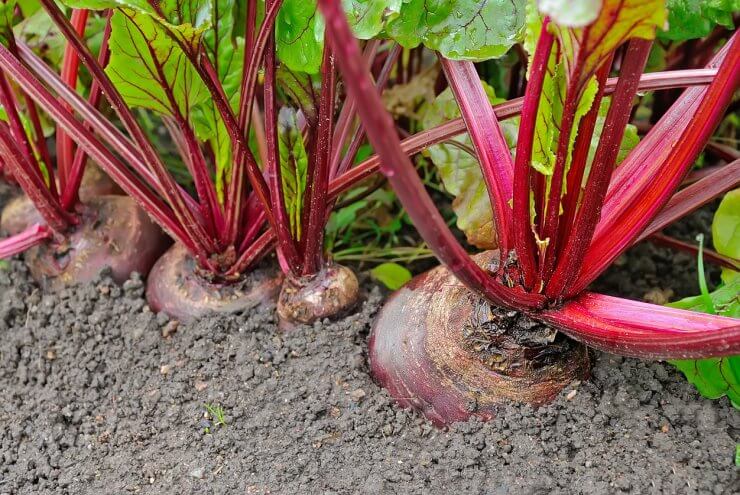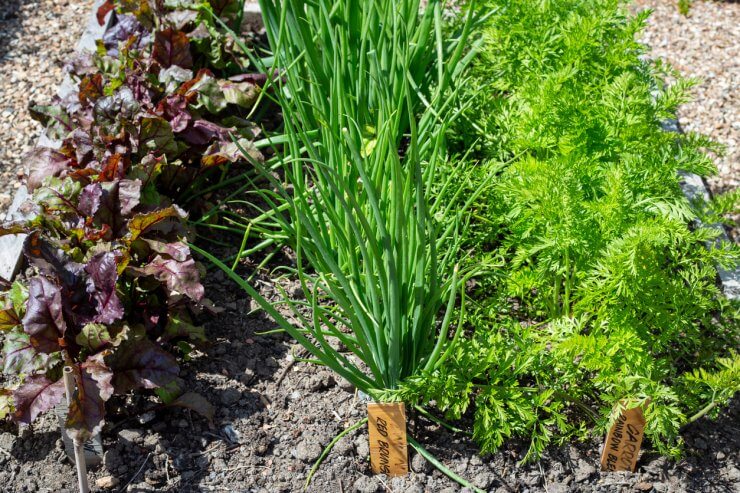
Beetroot growing in the ground
Planting
The easiest way to plant beets is to plant seeds directly in the ground. For spring plantings in temperate zones, plant your seeds once the soil temperature has reached at least 40 degrees F. Keep in mind that beets do not tolerate heat well, so choose a variety that won’t get caught in the harsh heat of summer. In areas with hot summers, stop sowing beet seeds 60 days before full summer arrives.
You can also plant beets again in late summer for an early autumn harvest—about six to eight weeks before the first frost. Sow seeds just once, since this is a narrower growing window than spring into summer.
If you’re in a region with mild winters, you can plant more seeds in the fall for a winter harvest.
Plant seeds about an inch apart in holes or furrows about a half inch deep. Cover loosely with soil and water. As with all plantings, don’t kill your seeds with kindness; take it easy with the water.
Keep the soil evenly moist during the germination period and throughout the growing season. Uneven watering can earn you cracked roots.
Plant Spacing
When your seedlings get to be 2 to 3 inches tall, thin them to 3 inches apart. Don’t just yank the extra seedlings out—you could easily disrupt the root system of the plant you want to keep. A better approach is to use garden snips to cut the leaves off at soil level. Take those little leaves inside and use them in soup or salad—they’re packed with vitamins and great flavor!
Your rows should be about a foot apart to give your plants room to grow and to give yourself some room to maneuver as you harvest. Keep in mind that you can snip one or two leaves from the plants as they’re growing and use those fresh leaves like you would fresh spinach. Don’t take more than a couple leaves—remember that the root needs the energy the leaves provide in order to grow.
As your beetroots grow, they’re going to start poking their heads above the soil line. Keep the roots protected by hilling up the soil around them as they grow.
Succession Planting
Beets need between 45 and 65 days to reach maturity. If you want to increase your beet harvest, plant new seeds every two to three weeks for a month or so—but only in regions where the high temperature tops out at 75 degrees F or less. Temperatures higher than that will cause your beet plants to bolt, rendering the roots too tough to eat and the leaves too bitter.
Companion Planting

Young beetroot, onions, and carrot plants growing in a garden
Companion planting matches plants with soil and nutrient needs different enough that they help, rather than hinder, the growth of both plants. Kohlrabi and onions will do well as companion plants with beets, as will lettuce, cabbage, radishes, broccoli, Brussels sprouts, cauliflower, chard, and catnip. Avoid pole beans and field mustard.
Good companion plants can help attract beneficial insects and deter pests, from small insects to hungry herbivorous mammals like rabbits and deer. Companion planting also helps add nutrients to the soil, reduce soil erosion, and shelter your beets from harsh weather and hot sun.
Raised beds
A raised garden bed or planter is an excellent option for growing beets if you don’t have soil that’s ideal for beets (heavy clay soil, for example). Raised beds also help with drainage, which is essential for healthy beet plants. You can even buy raised beds or build one yourself to fit your space. Planters should have holes in the bottom of the container and a drip tray underneath to guard against overwatering.
Watering and weeding will be easier if you have your beets in a raised bed or planter. It’s a good alternative to growing in open land. And if you fill a raised bed with packaged garden soil, you know you’re providing a cleaner and healthier environment for your plants from the outset.
Packaged garden soil means less weeding than you’d have from digging a hole in the ground; and with a raised bed or container, there’s less bending down to do your weeding!
How do you plant your beets? What criteria for site selection has worked for you? Do you use your beets as companion plants? Please share your ideas with us.


 Previous
Previous


Do the magazines come as a hard copy? If so, how do I subscribe?